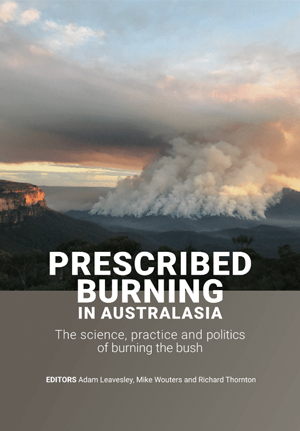 Editors
Editors
Adam Leavesley, Mike Wouters and Richard Thornton
Reviewed by Ewan Waller
Land, forest and bush fire manager, consultant and farmer
Published by
Australasian Fire and Emergency Service Authorities Council
ISBN
0994258941, 9780994258946
Prescribed Burning in Australasia: the science, practice and politics of burning the bush is the latest attempt to consolidate the voices, opinions and the science on prescribed or planned burning (referred to as burning in this review) across Australasia. And it does it well with authors from all fields – land and fire agencies, academia, indigenous contributors and field practitioners. Make no mistake; you are reading the writings from the experts on burning.
The book is so timely, as Australasia and the world grapple with the wildfire problem and search for ways to lessen the consequences.
The format, with one to four pages on each subject, makes it easy reading and has forced the authors to be pointed and concise. There is good referencing so the reader can easily follow up for a deeper understanding.
Rather than go into the detail what each chapter reveals, I will highlight a few key points, especially the gems or those findings that made me sit up and say – wow!
For me the best gem was the chapter on Aboriginal burning with points like:
- 'fire has spirit and authority and will shape the land based on the culture of the wielder'
- 'if you look after country, it will look after you'
- 'if you heal country, you heal community’ – so true as our communities and beloved bush suffer and try to heal from repeated high intensity bush fires
- 'you can always add to a small fire but cannot take away from a big fire' must be told to everyone before they light a burn.
And I encourage you to find the many gems that resonate with you throughout the book.
It is apparent that there are still differing opinions between the authors on burning. This book gives you the opportunity to follow the threads on the different perspectives and make up your own mind, hopefully without bias. Of course, the authors also agree on many factors including:
- burning close to assets gives the best protection
- crown fires are unlikely in burns at least up to five years old
- strategic burning based on risk modelling is the most effective.
Most researchers and land managers call for more research and some give the impression that this is needed before burning can proceed on any scale. Is this inertia appropriate as we face hotter and drier times?
I strongly favour the adaptive management approach of the writers on burning in water catchments. They show clearly that there are gaps in knowledge but provide a best practice guide through their recommended approach in an easy-to-apply table. More scientists must do this for their field of expertise, so burning programs can push ahead based on the best knowledge at the time.
It is apparent northern Australia really has its burn management well developed and working and are gaining the benefits such as carbon credit sales and a better environment. Likewise, Western Australia shows what leadership and decades of large area burning can do to reduce the damage from bushfires in the south-west corner of the state.
As I closed the book, I pondered - had it informed us on two key questions?
- What is the risk of loss from the now common massive fires compared to the possible loss of values from burning and difficulty in burning to the scale needed for adequate protection?
- What is the broad scale alternative to protect us and the bush from fire, if burning is not the answer?
A few things I looked for but were not included were the community voice on burning, especially from those close to the bush; what a national burn and fire policy might look like; and more commentary on why governments will not strongly invest in bushfire prevention through burning over the futility and costly attempts of trying to control the big fires.
Overall, however, the book does achieve the intent of objectively providing a lot of the evidence around burning. How we tackle the bushfire crisis in our land is so demanding and there is a need for real urgency in applying workable approaches in prevention.
Prescribed Burning in Australasia: the science, practice and politics of burning the bush is a must-read for these challenging times.


